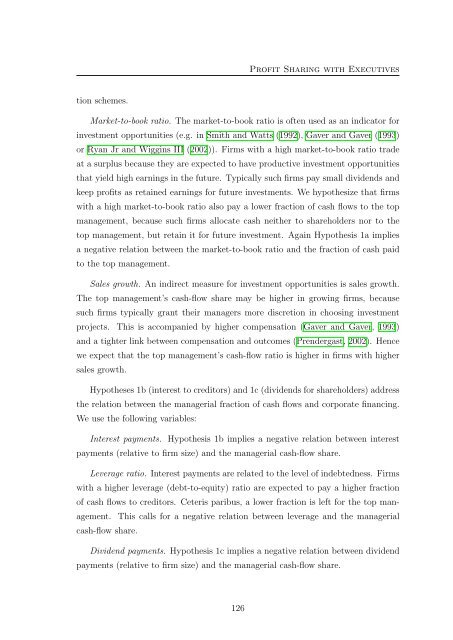Three Essays on Executive Compensation - KOPS - Universität ...
Three Essays on Executive Compensation - KOPS - Universität ...
Three Essays on Executive Compensation - KOPS - Universität ...
You also want an ePaper? Increase the reach of your titles
YUMPU automatically turns print PDFs into web optimized ePapers that Google loves.
Profit Sharing with <strong>Executive</strong>s<br />
ti<strong>on</strong> schemes.<br />
Market-to-book ratio. The market-to-book ratio is often used as an indicator for<br />
investment opportunities (e.g. in Smith and Watts (1992), Gaver and Gaver (1993)<br />
or Ryan Jr and Wiggins III (2002)). Firms with a high market-to-book ratio trade<br />
at a surplus because they are expected to have productive investment opportunities<br />
that yield high earnings in the future. Typically such firms pay small dividends and<br />
keep profits as retained earnings for future investments. We hypothesize that firms<br />
with a high market-to-book ratio also pay a lower fracti<strong>on</strong> of cash flows to the top<br />
management, because such firms allocate cash neither to shareholders nor to the<br />
top management, but retain it for future investment. Again Hypothesis 1a implies<br />
a negative relati<strong>on</strong> between the market-to-book ratio and the fracti<strong>on</strong> of cash paid<br />
to the top management.<br />
Sales growth. An indirect measure for investment opportunities is sales growth.<br />
The top management’s cash-flow share may be higher in growing firms, because<br />
such firms typically grant their managers more discreti<strong>on</strong> in choosing investment<br />
projects. This is accompanied by higher compensati<strong>on</strong> (Gaver and Gaver, 1993)<br />
and a tighter link between compensati<strong>on</strong> and outcomes (Prendergast, 2002). Hence<br />
we expect that the top management’s cash-flow ratio is higher in firms with higher<br />
sales growth.<br />
Hypotheses 1b (interest to creditors) and 1c (dividends for shareholders) address<br />
the relati<strong>on</strong> between the managerial fracti<strong>on</strong> of cash flows and corporate financing.<br />
We use the following variables:<br />
Interest payments. Hypothesis 1b implies a negative relati<strong>on</strong> between interest<br />
payments (relative to firm size) and the managerial cash-flow share.<br />
Leverage ratio. Interest payments are related to the level of indebtedness. Firms<br />
with a higher leverage (debt-to-equity) ratio are expected to pay a higher fracti<strong>on</strong><br />
of cash flows to creditors. Ceteris paribus, a lower fracti<strong>on</strong> is left for the top management.<br />
This calls for a negative relati<strong>on</strong> between leverage and the managerial<br />
cash-flow share.<br />
Dividend payments. Hypothesis 1c implies a negative relati<strong>on</strong> between dividend<br />
payments (relative to firm size) and the managerial cash-flow share.<br />
126
















